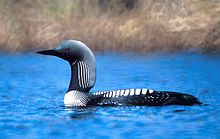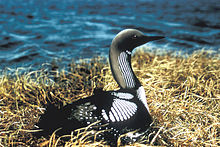| Pacific loon | |
|---|---|

| |
|
Scientific classification
| |
| Domain: | Eukaryota |
| Kingdom: | Animalia |
| Phylum: | Chordata |
| Class: | Aves |
| Order: | Gaviiformes |
| Family: | Gaviidae |
| Genus: | Gavia |
| Species: | G. pacifica
|
| Binomial name | |
| Gavia pacifica (
Lawrence, 1858)
| |

| |

The Pacific loon or Pacific diver (Gavia pacifica), is a medium-sized member of the loon, or diver, family.
Taxonomy and etymology
The Pacific loon, previously considered conspecific with the similar black-throated loon, was classified as a separate species in 1985. The genus name Gavia comes from the Latin for "sea mew", as used by ancient Roman naturalist Pliny the Elder. [2] The specific epithet pacifica is Latin for the Pacific Ocean, the term meaning "peaceful". [3]
The phylogeny of this species is debated, with the black-throated loon and the Pacific loon traditionally being considered sister species, whereas a study using mitochondrial and nuclear intron DNA supported placing the black-throated loon sister to a clade consisting of the Pacific loon and the two sister species that are the common loon and the yellow-billed loon. In the former phylogeny, the split between the Pacific loon and the black-throated loon is proposed to have happened about 6.5 million years ago. [4]
Description
Breeding adults are like a smaller sleeker version of common loon. They measure 58–74 cm (23–29 in) in length, 110–128 cm (43–50 in) in wingspan and weigh 1–2.5 kg (2.2–5.5 lb). [5] They have a grey head, black throat, white underparts and chequered black-and-white mantle. The black throat has purple reflections. Non-breeding plumage is drabber with the chin and foreneck white. [6] Its bill is grey or whitish and dagger-shaped.
In all plumages, lack of a white flank patch distinguishes this species from the otherwise very similar black-throated loon. The Pacific loon can be differentiated from the red-throated loon in winter by the latter's paler look, the fact that the red-throated loon has less of a contrast between both the crown and hindneck and the throat, and the bill that looks to be upturned. [6]
Like other gaviiformes, the Pacific loon's legs are located towards the back of its body making it difficult for it to walk on land. The leg placement helps the loons efficiently forage for food underwater. The physiological structure of the Pacific loon makes taking off from land practically impossible, and the loon requires 30-50 yards on the water to successfully attain flight. [7] This distance requirement for takeoff limits the number of lakes the Pacific loon can realistically breed and forage on.
Calls
The Pacific loon most actively calls in the spring and summer and has a wide range of calls. When feeding, the Pacific loon may produce an “ark”-like vocalization, a sharp, short call. Additionally, the Pacific loon has a call similar to that of its relative the common loon, it is a loud, eerie, oo-loo-lee wail or yodel that can travel for miles and is typically heard during the loon's breeding season. The loons can also make short and harsh “kok-kok-kok-kok” calls along with a range of other smaller cackles, growls, barks, and clucking noises. [6] [7]

Habitat and range
The Pacific loon breeds on tundra lakes, and winters in the open ocean or other large bodies of water. It breeds primarily in northern Canada and eastern Siberia, and winters along the Pacific coast of North America. [8]
Movements
Unlike other loons/divers, this bird may migrate in flocks. It winters at sea, mainly on the Pacific coast, or on large lakes over a much wider range, including China, Japan, North Korea, South Korea, United States and Mexico. It has occurred as a vagrant to Greenland, Hong Kong, Great Britain, Spain, Finland and Switzerland (Dec 2015). [9]
Behaviour
Breeding
The Pacific loon constructs its nest on the ground near deep lakes. This nest is made out of piled-up vegetation. [10]
This loon lays a clutch of one to two light buff or green eggs with brown spots of various sizes. These eggs typically measure 76 by 47 millimetres (3.0 by 1.9 in). Although the eggs are laid a few days a part, they can usually be seen to hatch at intervals not more than a day. Incubation lasts 23 to 25 days. [10]
Territoriality
Socially monogamous Pacific loons have been found to have high territory retention rates (0.92) indicating that the loons are able to successfully defend their nesting lake from other loon pairs or individuals who may be trying to move in. Furthermore, males have a greater success at territory retention than females, but no evidence suggests that this difference is attributed to size but is rather due to fighting ability or familiarity with territory. [11]
Pacific loons prospecting for a new lake frequently visited lakes that were already occupied, this along with high retention rates of lakes indicates that the loon population in Northern Alaska may be saturated. The Pacific loon has also been known to be very aggressive, engaging in interspecific killing of both hatch year and after hatch year individuals who intentionally or accidentally approach the loon's nesting area. [12]
A pair of Pacific loons will defend young as a parental unit in which one parent protects the nest or fledglings while the other parent aggressively attacks the perceived threat. If the threat is another animal on the water, the attacking loon will extend its head and neck in an aggressive manner and dive under the threat in an attempt to stab it with its beak as it resurfaces. [13] [12] Pacific loons are so aggressive, they have even been observed displaying threatening body language towards passing airplanes in Alaska. [13]
Diet
This species, like all divers/loons, is a specialist fish-eater, catching its prey underwater. It also forages in groups, usually swimming under schools of fish and forcing them up towards the surface. [10] It does, although, generally feed closer to the shore than other loons. [6]
Conservation
The Pacific loon population is currently increasing and is spread over a wide range of approximately 15,700,000 square kilometers. [14] Current efforts of conservation are focused around loon population monitoring and maintaining accurate counts of populations and breeding behaviors. A recent in depth study of the Pacific loon population in the Western Alaskan Arctic found that the population of the birds there is actually ~1.5-2.0 times larger than previous aerial surveillance had indicated. The study indicated potential encroachment upon the National Petroleum Reserve in Alaska (NPRA), one of the Pacific loons primary breeding grounds, by natural gas and oil companies as a potential threat to Pacific loons. [15]
One harmful environmental pollutant to the Pacific loon population is heavy metals like mercury, which can be observed in their habitat as a result of legacy mining in the areas the loons migrate through and hunt in. It has been shown that elevated levels of mercury in the environment poses a significant health risk to avian piscivores like the Pacific loon. [16] Mercury is up-taken by small fish which is a primary source of food in a loon's diet. When a loon eats the fish it will incorporate the mercury from the fish into its body, which can cause adverse health effects.
Additionally, it has been shown that nest visits from researchers and capture events can have a significant impact on the survival rates within Pacific loon nests. When investigators capture Pacific loons while they are breeding or incubating eggs regardless of how close they are to the nest at the time of capture, the survival rates of the eggs decrease. [11] This is most likely due to the fact that Pacific loons nest in a traditionally remote part of Western Alaska and are not typically accustomed to human interaction of any form. The lowered survival rate of the loon's offspring when a parent is captured or the nest is visited indicates that the population could face severe consequences from encroaching human contact.
Reports also exist of Pacific loons ingesting polluted plastic, a problem that is becoming an increasingly high concern among avians in Canada and across the globe. Luckily, the diving foraging behavior of loons keeps them at a relatively low risk of death from overconsumption of plastic, as most of the polluted debris exists floating on the surface of the water rather than in the depths. [17]
References
- ^ BirdLife International (2018). "Gavia pacifica". IUCN Red List of Threatened Species. 2018: e.T22697839A132607134. doi: 10.2305/IUCN.UK.2018-2.RLTS.T22697839A132607134.en. Retrieved 12 November 2021.
- ^ Johnsgard, Paul A. (1987). Diving Birds of North America. University of Nevada–Lincoln. ISBN 0-8032-2566-0.
- ^ Jobling, James A (2010). The Helm Dictionary of Scientific Bird Names. London: Christopher Helm. p. 288. ISBN 978-1-4081-2501-4.
- ^ Sprengelmeyer, Quentin D. (2014). A phylogenetic reevaluation of the genus Gavia (Aves: Gaviiformes) using next-generation sequencing ( Master of Science). Northern Michigan University.
- ^ [1] (2011).
- ^ a b c d Bull, John L.; Farrand, Jr., John (1994). The National Audubon Society Field Guide to North American Birds: Eastern region (2 ed.). Knopf. pp. 338–339. ISBN 978-0-679-42852-7.
- ^ a b "Online bird guide, bird ID help, life history, bird sounds from Cornell". All About Birds. Retrieved 2020-10-06.
- ^ Peterson, Roger Tory (2002). A Field Guide to the Birds of Eastern and Central North America (5th ed.). New York, NY, USA: Houghton Mifflin Harcourt. p. 9. ISBN 978-0-395-74047-7.
- ^ "Pacific Loon Spotted on Finnish Lake". YLE.fi. Yleisradio Oy. November 16, 2010. Retrieved January 29, 2011.
- ^ a b c Hauber, Mark E. (1 August 2014). The Book of Eggs: A Life-Size Guide to the Eggs of Six Hundred of the World's Bird Species. Chicago: University of Chicago Press. p. 54. ISBN 978-0-226-05781-1.
- ^ a b Uher-Koch, Brian D; Wright, Kenneth G; Schmutz, Joel A (2019-02-01). "The influence of chick production on territory retention in Arctic-breeding Pacific and Yellow-billed loons". The Condor. 121 (1): duy021. doi: 10.1093/condor/duy021. ISSN 0010-5422. S2CID 198160438.
- ^ a b Kirkham, Ian R.; Johnson, Stephen R. (1988). "Interspecific Aggression in Loons (Agresión Interespecífica en Somormujos (Gavia spp.))". Journal of Field Ornithology. 59 (1): 3–6. ISSN 0273-8570. JSTOR 4513284.
- ^ a b Robertson, Gregory J. (1993). "Interspecific Killing in the Pacific Loon". The Wilson Bulletin. 105 (3): 534–535. ISSN 0043-5643. JSTOR 4163337.
- ^ "The IUCN Red List of Threatened Species". IUCN Red List of Threatened Species. Retrieved 2020-10-06.
- ^ Schmidt, Joshua H.; Flamme, Melanie J.; Walker, Johann (2014). "Habitat use and population status of Yellow-billed and Pacific loons in western Alaska, USA". The Condor. 116 (3): 483–492. doi: 10.1650/CONDOR-14-28.1. ISSN 0010-5422. JSTOR 90008469. S2CID 84904494.
- ^ Jackson, Allyson; Evers, David C.; Eagles-Smith, Collin A.; Ackerman, Joshua T.; Willacker, James J.; Elliott, John E.; Lepak, Jesse M.; Vander Pol, Stacy S.; Bryan, Colleen E. (October 2016). "Mercury risk to avian piscivores across western United States and Canada". Science of the Total Environment. 568: 685–696. Bibcode: 2016ScTEn.568..685J. doi: 10.1016/j.scitotenv.2016.02.197. PMC 5461577. PMID 26996522.
- ^ Provencher, Jennifer F.; Bond, Alexander L.; Mallory, Mark L. (March 2015). "Marine birds and plastic debris in Canada: a national synthesis and a way forward". Environmental Reviews. 23 (1): 1–13. doi: 10.1139/er-2014-0039. ISSN 1181-8700.
Further reading
The following articles deal with separation of Pacific diver/Pacific loon from black-throated diver/Arctic loon:
- Birch, A. and Lee, C-T, 1997, Field identification of Arctic and Pacific Loons, Birding 29: 106–115.
- Birch, A and Lee, C-T, 1995, Identification of the Pacific Diver - a potential vagrant to Europe, Birding World 8: 458–466.
- Harrison, Peter (1988). Seabirds: An Identification Guide. London: Christopher Helm. ISBN 0-7470-1410-8
External links
- Stamps [usurped] (for Canada)
- Pacific loon photo gallery - VIREO
